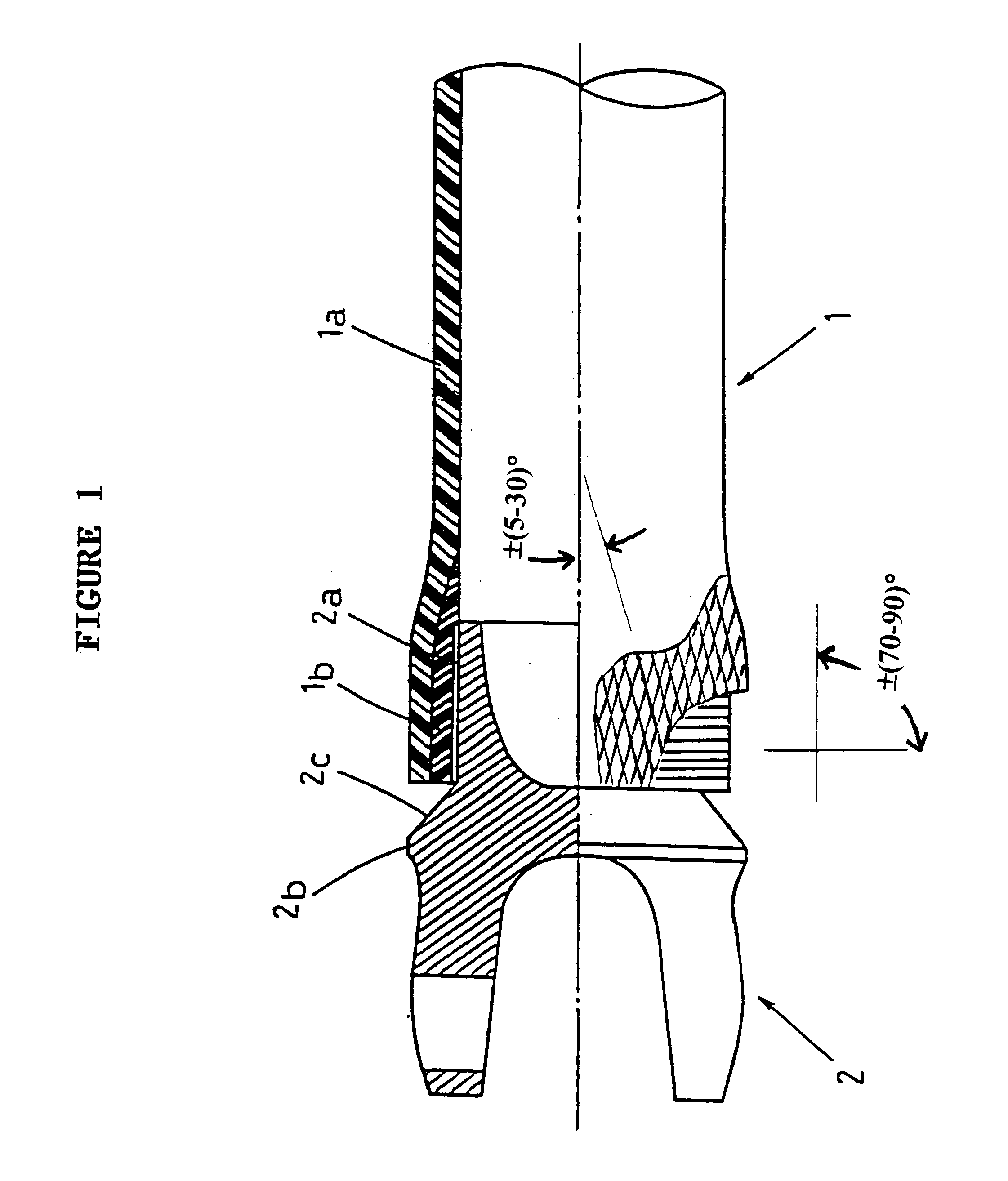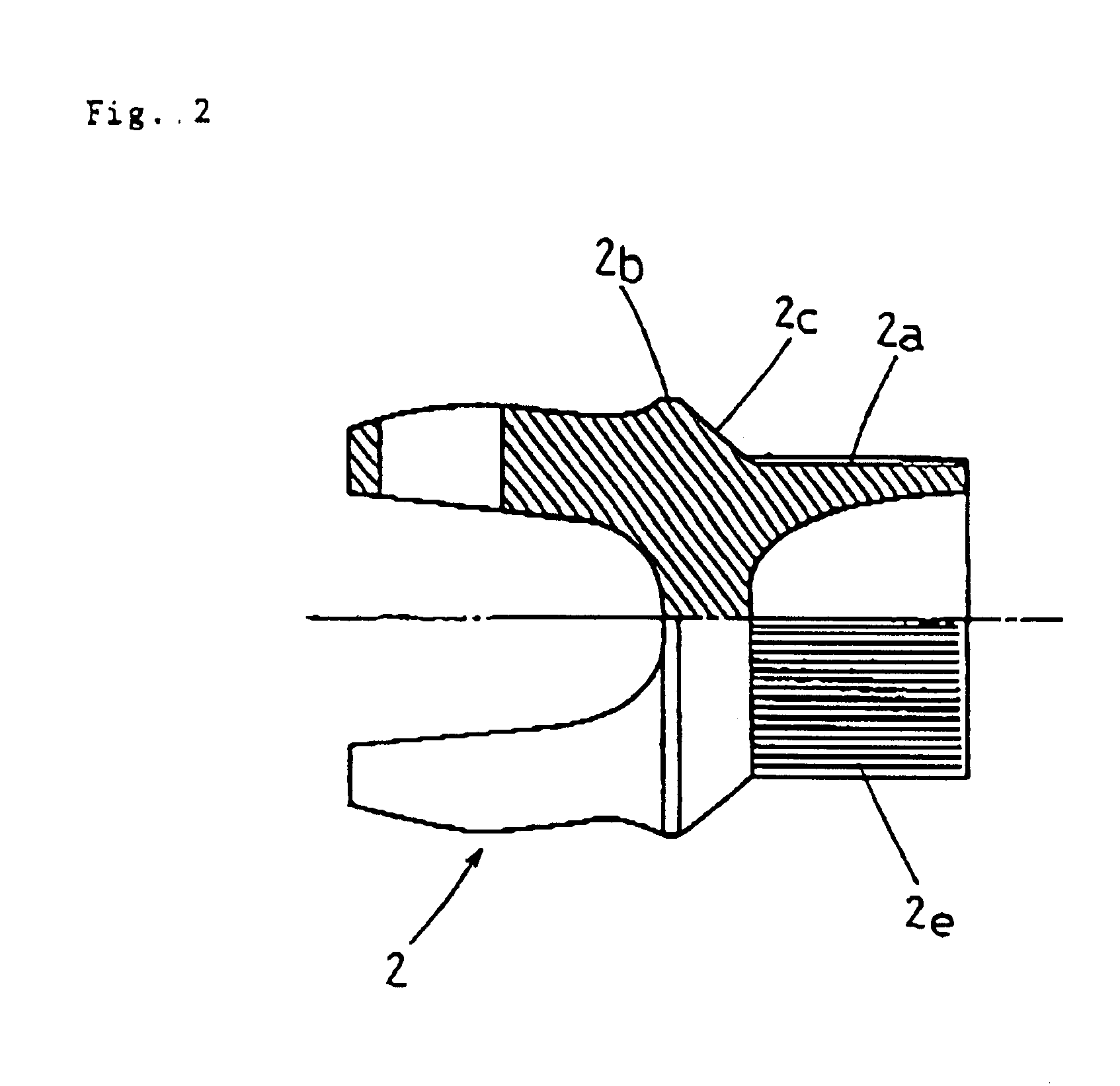Shock absorbing tube
a technology of shock absorption tube and shock absorption tube, which is applied in the direction of shafts, shafts, mechanical equipment, etc., can solve the problems of deterioration of the impact energy absorption effect, complicated production process, and complicated structur
- Summary
- Abstract
- Description
- Claims
- Application Information
AI Technical Summary
Benefits of technology
Problems solved by technology
Method used
Image
Examples
example 2
A shock absorbing tube as shown in FIG. 4 was obtained in the same manner as in Example 1 except that a joint was used the protrusion 2b of which had an outer diameter of 75 mm, which was the same as that of the end member 1b.
In a torsion test, the shock absorbing tube was found to have a torsional strength of 350 kgf.m and a critical revolution of 11,000 rpm, both of which proved satisfactory for a shock absorbing tube for automobiles.
Next, when an axial compressive load was applied, the main body and the end member were separated from each other at 11,000 kgf, and the rupture of the main body started. After the rupture, sequential breakage proceeded at a load of 3,500 kgf as shown in FIG. 5.
example 3
A shock absorbing tubes for collapsible handle system as shown in FIG. 4 was obtained in the same manner as in Example 1 except the following changes.
Firstly, the number of bungles of the end member was changed to four bundles (numbers of single fibers in total: 48,000) and four layers of fibers were wound on one end section of a length of 40 mm so as to be at an angle of .+-.85.degree. with respect to the axial direction to thereby form an end member having a thickness of 1.5 mm. After this, the procedure moved to the other end to form a similar end member on the other end section, and then two layers were wound over the entire length of the mandrel at an angle of .+-.22.5.degree. with respect to the axial direction to thereby form a main body having a thickness of 1.0 mm. Further, one layer was hooped over the entire length of the mandrel at an angle of -85.degree. with respect to the axial direction.
The shock absorbing tube had an end-portion outer diameter of 40 mm, a main body ...
example 4
A similar shock absorbing tubes to that of Example 3 was obtained in the same manner as in Example 3 except changing the end member to that made of aluminum.
When an axial compressive load was applied selectively to the end member of the shock absorbing tube, the main body and the end member were separated from each other at 300 kgf to thereby start rupture of the main body. After the rupture, sequential rupture as shown in FIG. 10 took place at a load of 150 kgf.
The shock absorbing tube of this invention is equipped with a compressive load transmitting section which concentrates a compressive load acting in the axial direction of the joint on the interface between the main body and the end member to thereby separate the main body and the end member from each other. Thus, as shown with reference to the embodiments, it is possible, at the time of collision, to allow the rupture of the shock absorbing tube to proceed reliably with the rupture of the car body while satisfying the fundam...
PUM
 Login to View More
Login to View More Abstract
Description
Claims
Application Information
 Login to View More
Login to View More - R&D
- Intellectual Property
- Life Sciences
- Materials
- Tech Scout
- Unparalleled Data Quality
- Higher Quality Content
- 60% Fewer Hallucinations
Browse by: Latest US Patents, China's latest patents, Technical Efficacy Thesaurus, Application Domain, Technology Topic, Popular Technical Reports.
© 2025 PatSnap. All rights reserved.Legal|Privacy policy|Modern Slavery Act Transparency Statement|Sitemap|About US| Contact US: help@patsnap.com



